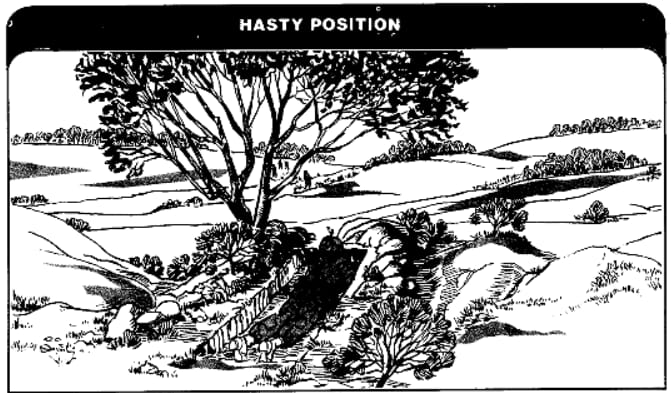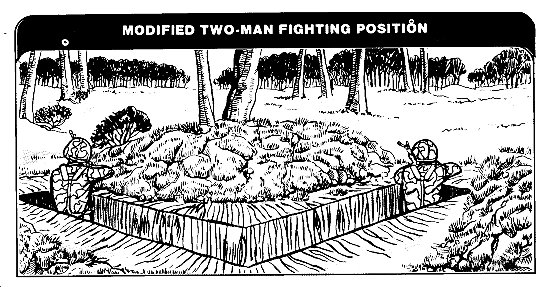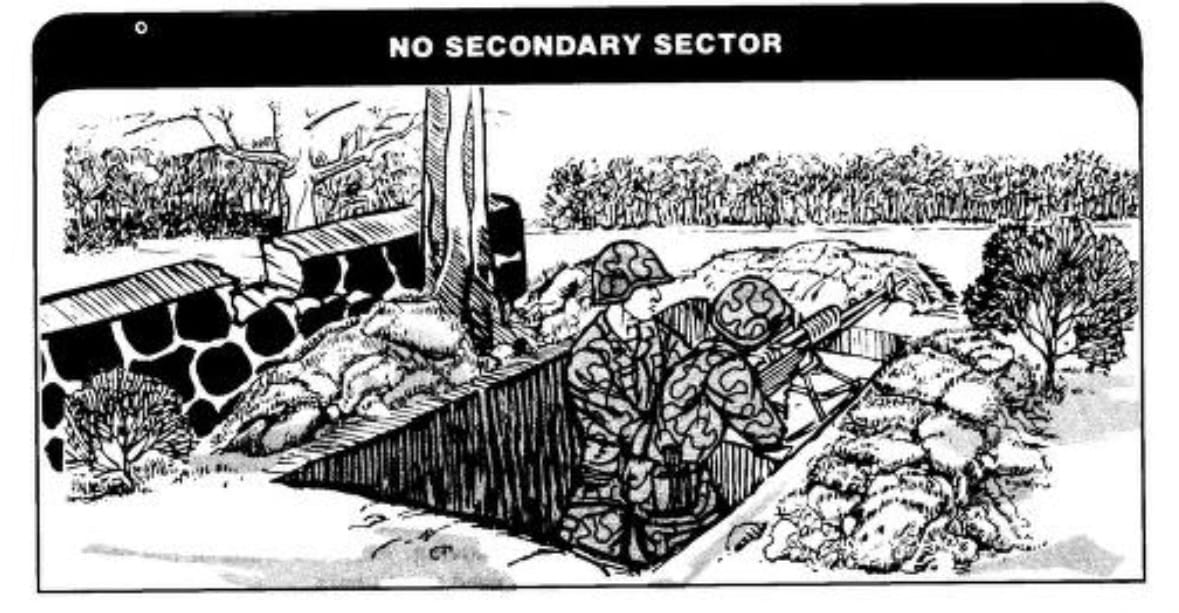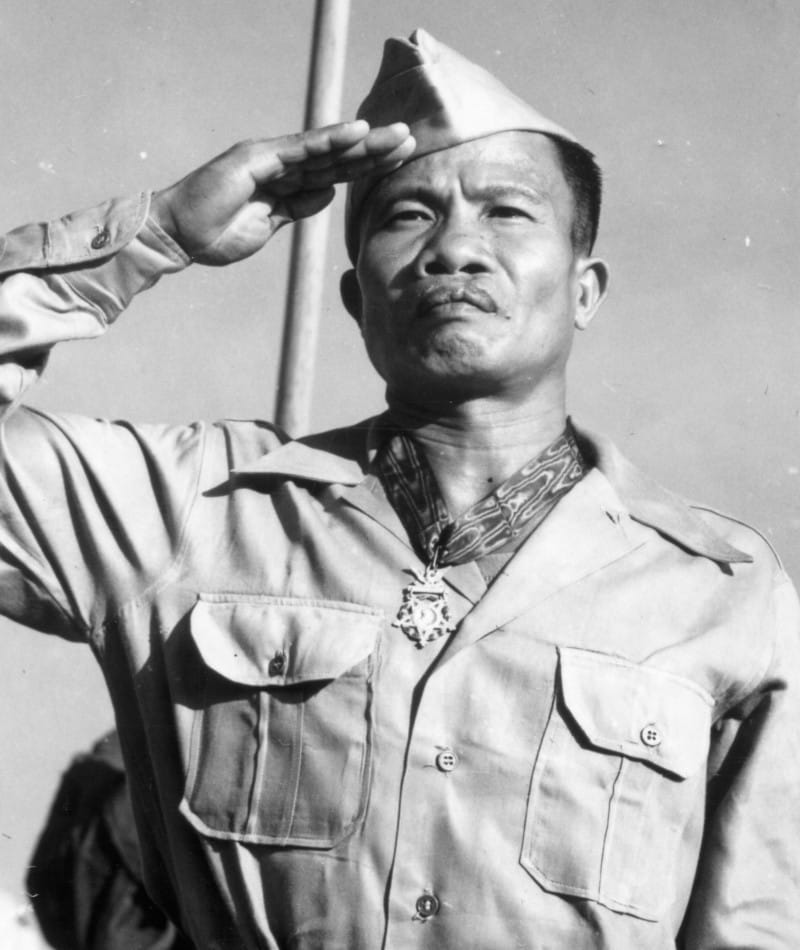- Formidable Function
- Posts
- LP/OP #5
LP/OP #5
Fighting Positions
Welcome back to the Listening Post/Observation Post (LP/OP), friend.
This newsletter shares insights from the highly pragmatic military methodologies learned throughout my nearly 20 years spent as a professional in the military and private sector.
We do so clearly and concisely with respect for your time.
Every edition we cover new…
Tactics, Techniques, and Procedures (TTPs)
Inspirational Exemplars
This week is all about fighting positions.
Fighting has become faux pas to a degree in modern society, but don’t be naive, fighting has simply evolved from the primitive imagery you may have in mind. Psyops are now being conducted in nearly every facet of our lives. Don’t be lulled to sleep by your adversaries or competition.
Be prepared to fight.
#1: The Hasty Fighting Position

A hasty fighting position is quickly established with minimal use of tools and time.
It provides immediate cover and concealment, allowing forces to engage with a basic level of protection. These are typically used when contact with the enemy is expected imminently, and there is not enough time to prepare a more elaborate and bolstered defensive emplacement.
Pros:
Quick to establish.
Allows for immediate action and responsiveness.
Minimal resource requirement.
Cons:
Offers limited protection and durability.
May not provide optimal firing angles or comfort.
In entrepreneurship, a hasty fighting position can be likened to quick, reactive market entries or product launches that capitalize on emerging trends.
These initiatives are agile but may lack thorough research or preparation. As Dan Koe is quoted as saying, “Advice is not starting”. I also like Chris Williamson’s take on the matter, “Talking about the thing is not doing the thing” - (comprehensive list of things that are not doing the thing)
Get in the fight, take up a hasty fighting position if you have to and move!
Inaction is not an option.
#2: The Prepared Fighting Position

Prepared fighting positions are constructed positions designed to offer better protection and sustained operational endurance and effectiveness.
Pros:
Provides substantial protection and modicum of comfort.
Enables sustained operational capability.
Incorporates comprehensive planning and resources.
Cons:
Can be time-consuming and resource-intensive to establish.
Less flexible to sudden changes in the tactical environment.
In business application, prepared “fighting” positions are tantamount to an enterprise’s “strategic position” or “strategic stance”.
Prepared positioning involves strategic planning concepts where entrepreneurs or organizations invest significant time and resources in developing a new venture, thorough market analysis, customer avatar assessments, positioning, and robust infrastructure establishment before launch.
On a personal level, your prepared fighting position may involve meticulous career planning or methodical development of skills, ensuring when opportunities arise, you are well-prepared to excel and sustain success. If you don’t know where to start, pick a skill that interests you and find a course to pursue. There is a new educational wave occurring in the skills acquisition space, and there has never been a better time to start your one-person business as Dan Koe advises.
If you don’t prepare and position yourself to fight and prevail, you are simply planning to fail.
#3: The Alternate Fighting Position

Alternate fighting positions are secondary positions prepared to provide options and safety should a primary position become compromised.
Pros:
Offers strategic flexibility and backup.
Enhances survivability and adaptability.
Maintains operational continuity under pressure.
Cons:
Requires additional resources and time.
May divide focus during preparation.
As your product(s) or service(s) have gone to market, or you’re getting them to market, having an alternate strategy or backup plan, such as diversification of product lines or markets, provides a safety net against unforeseen market dynamics. It is highly beneficial to have a “pivot plan” in mind for your product(s) or service(s) should any market shock occur.
For you personally, having backup plans, such as alternative career paths or emergency funds, can provide security and options when primary plans falter. Best of luck to you if you plan to go “all in” on your new venture, but pros practice prudence. Winners have typically won the competition through planning before the game has commenced - this includes having multiple alternate fighting positions should momentum not favor them in any stage of the fight.
Some of us are old enough to remember Netflix as a DVD renting disruptor, and not simply the streaming giant the globe has come to know. Netflix’s meteoric rise can be traced back to a crucial pivot point where they chose to take up an alternate fighting position. This decision not only won the battle they were locked in with traditional movie rental firms, but it proved to be the decisive blow some might argue, in winning a major war in the home entertainment industry.
Fight smart and flexible.
Inspiration: Captain Jose Calugas
United States Army
88th Field Artillery Regiment 1st Battalion Battery B Philippine Scouts |  |
During the Battle of Bataan in World War II, at the time a Sergeant, Jose Calugas expertly applied the principles of the multiple fighting positions covered above.
His heroic actions earned him the honor of being the second Filipino American to earn the Medal of Honor
When he noticed that a vital artillery piece had been disabled, he maneuvered across open ground to organize a team to place the downed artillery back into action.
This act of bravery and leadership helped secure a critical defensive position during the battle and exemplified the strategic use of fighting positions under fire.
Hasty Fighting Position: Calugas demonstrated the essence of a hasty fighting position by quickly taking action to reestablish the artillery position under immediate threat, ensuring the unit could continue to defend against the advancing enemy.
Prepared Fighting Position: His ability to organize and prepare the artillery crew amidst chaos showed his foresight and preparation, turning a vulnerable moment into a fortified defensive action.
Alternate Fighting Position: By adapting quickly and utilizing the available resources to secure the artillery, Calugas effectively abandoned his initial fighting position and took up an alternate fighting position, reinvigorating his forces’ line of defense, ensuring continued operational effectiveness under intense fire.
After the battle, Sergeant Calugas was captured and endured the infamous Bataan Death March.
Jose Calugas was awarded the Medal of Honor on April 30, 1945.
His survival and sustained resilience embody the American spirit and demonstrated his extraordinary bravery and determination.
Outbrief
Lessons Learned (L2): Establish quick responses, prepare thoroughly for sustained success, and always have a backup plan.
Knowing your fighting positions and being willing to take them up in your life will give you tangible advantages.
Hasty Fighting Positions
Prepared Fighting Positions
Alternate Fighting Positions
Jose Calugas executed these concepts under duress at the Battle of Bataan.
His selfless contributions remind us of the importance of adaptability, preparation, and resilience. As we reflect on Calugas' ability to lead with bravery and foresight, strive to apply these military-derived strategies to your daily mindset. What type of fighting position will you take up today? Because you don’t have a choice but to fight. As General James Mattis advised, “the enemy gets a vote”.
Move intentionally every given day as Jose Calugas did, and you will find yourself more resilient and formidable.
That’s this week’s brief!
Thank you genuinely for reading and see you next time.
— Ryan “DQ” DeQuiroz —